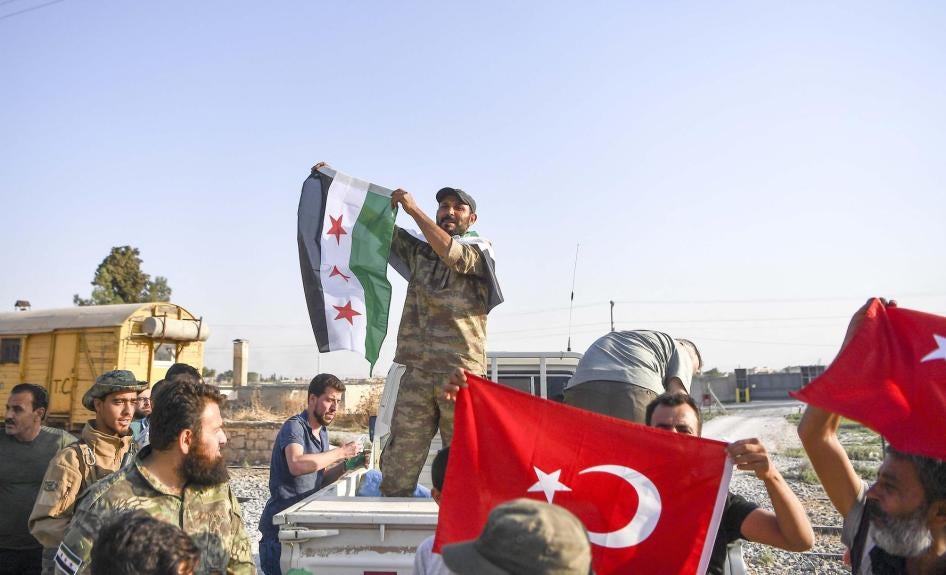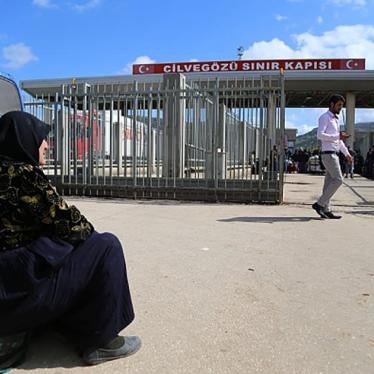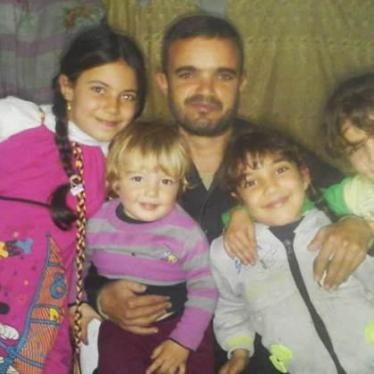(Beirut) – Factions of the Syrian National Army (SNA), a Syrian non-state armed group backed by Turkey in northeast Syria, have summarily executed civilians and failed to account for aid workers who disappeared while working in the ‘safe zone,’ Human Rights Watch said today. The armed group has also apparently refused to allow the return of Kurdish families displaced by Turkish military operations and looted and unlawfully appropriated or occupied their property.
Turkey should investigate human rights abuses, in many cases potential war crimes, in territory over which they currently exercise effective control, press SNA forces to end these abuses, and ensure that those responsible are held to account. Local commanders of the group should also investigate and hold individuals responsible for the abuses accountable.
“Executing individuals, pillaging property, and blocking displaced people from returning to their homes is damning evidence of why Turkey’s proposed ‘safe zones’ will not be safe,” said Sarah Leah Whitson, Middle East director at Human Rights Watch. “Contrary to Turkey’s narrative that their operation will establish a safe zone, the groups they are using to administer the territory are themselves committing abuses against civilians and discriminating on ethnic grounds.”
On October 9, 2019, Turkish Armed Forces and the armed group invaded territory in northeast Syria that since 2012 had been under the control of the Syrian Democratic Forces, made up primarily of the Kurdish-led People’s Protection Units (YPG). Since the incursion began, Turkey and the factions it supports have indiscriminately shelled civilian areas, carried out at least seven summary killings, unlawfully occupied private civilian homes and shops and looted the owners’ property, and have not accounted for aid workers who may have been forcibly disappeared while working in their zones.
Human Rights Watch interviewed 10 individuals, including 2 doctors and 3 relatives of victims, to document these abuses. Human Rights Watch also reviewed footage and images provided by activists and relatives that corroborate these abuses. On October 11, videos and images, including some posted by the SNA itself, have emerged on social media showing its members shooting at a person who was lying down without moving and appeared to pose no threat and standing atop the dead body of another person in a degrading manner. Human Rights Watch also documented the execution of a Kurdish political activist, Hevrin Khalaf, and researched what happened to three Kurdish Red Crescent aid workers who disappeared in SNA-controlled territory, including the apparent unlawful killing of at least one of them. Human Rights Watch interviewed three relatives and colleagues who verified the victims’ identities and the circumstances of their deaths.
Human Rights Watch also interviewed five Kurdish civilians between November 6 and 11 who said that the armed group’s forces were occupying their homes and other property and had arbitrarily prevented them or their relatives from returning. A Reuters journalist of Kurdish origin posted pictures of his house on October 30, claiming that the group had occupied it. In another case the group’s forces killed three Kurdish men who had been trying to return to the city of Ras al-Ayn, witnesses and relatives said, and prevented another Kurdish man from returning while allowing Arab residents to return.
Both international humanitarian law and human rights law prohibit unlawful killings and any arbitrary deprivation of life, which includes targeting civilians. International humanitarian law also strictly prohibits, and deems a war crime, the deliberate killing of injured, surrendered, or captured combatants (people deemed hors de combat) and enforced disappearances.
Under the laws of war, pillaging or forcibly taking private property for personal use is prohibited and can also constitute a war crime. Combatants are not allowed to seize property for personal use, which is a war crime, and the laws of war also prohibit destruction of property not justified by military necessity. International norms require protecting the property of displaced people against destruction and arbitrary and illegal appropriation, occupation, or use.
International law further stipulates that civilians who were forcibly displaced during a conflict should be allowed to return home as soon as possible without conditions. If forces have security concerns, then they should conduct individual assessments of residents, impose temporary, limited restrictions if justified, and not seek to impose blanket or indefinite bans to prevent them from returning. Occupiers are prohibited from moving segments of the population out of their homes for non-security reasons and seeking to replace them with populations from other territory.
All parties to a conflict are obliged to investigate alleged war crimes by their members and ensure that those responsible are appropriately punished. Commanders who knew or should have known about crimes committed by their subordinates but took no action to prevent or prosecute them can be held criminally liable as a matter of command responsibility.
The de facto authorities in the areas where Human Rights Watch has documented these abuses should ensure that those responsible are held to account, that it is safe for people to return if they wish, and that no one is refused the right to return on the basis of their ethnicity or identity, Human Rights Watch said. The Turkish government should also end its military assistance to SNA factions responsible for these abuses.
“Turkey is turning a blind eye to the reprehensible behaviour displayed by the factions it arms,” Whitson said. “So long as Turkey is in control of these areas, it has a responsibility to investigate and end these violations.”
Since the incursion into northern Syria started, Turkish Armed Forces and the SNA have taken control of the area between Tal Abyad (Gire Spi) and Ras al-Ayn (Serekaniye) and part of the international highway (the M4) running between southeast Turkey and northeast Syria. Despite an October 22 ceasefire and safe zone agreement between Russia and Turkey, clashes between the Syrian Democratic Forces – the Kurdish-led forces once backed by the United States-led coalition against the Islamic State (also known as ISIS) – and the SNA continue.
According to the United Nations, the incursion initially displaced at least 200,000 people, and about 100,000 are now returning. Almost half have returned to areas controlled by the Turkish-backed factions and the Turkish Armed Forces in Tal Abyad, Ein Issa, and Suluk.
Summary Killings and Enforced Disappearances
According to the Syrian Observatory for Human Rights, Syrian non-state armed groups executed nine civilians, including the Kurdish-Syrian politician Hevrin Khalaf, on October 12. Videos of Khalaf’s execution surfaced online on October 13. The videos Human Rights Watch reviewed show armed men standing over the body of a woman, which relatives and activists confirmed was Khalaf.
In another video, armed men who identify themselves as members of the SNA are seen shooting automatic weapons at a figure lying unmoving on the side of a road. Bellingcat, an open source investigative site, identified Ahrar al-Sharqiyeh forces, a faction of the SNA, as having been at both the Khalaf execution and the killing that appears in the second video. Ahrar al-Sharqiyeh denied its involvement in the killings.
In another case, a relative and two colleagues of the three Kurdish Red Crescent volunteers said an SNA faction that they could not identify advised them that they had detained the volunteers on October 11. A doctor who worked at the hospital with which they were associated told Human Rights Watch that he lost contact with the volunteer team – an ambulance driver and two nurses – who had gone to Suluk in response to an attack on October 11.
The driver’s uncle said that the driver’s brother had sent a text to the driver’s phone on October 14 and a person who identified himself as part of the SNA responded by text saying that the driver was dead and shared a photograph of the body. Both the relative and his colleague verified that the image was of the ambulance driver.
In photos on his Facebook account, the driver is dressed in a military uniform and a YPG flag is draped over his body in the pictures provided by his relatives. His relatives did not receive the body. Human Rights Watch could not determine whether the man was a volunteer with the Kurdish Red Crescent and simultaneously a member of the Kurdish armed group, or whether the Facebook photos were from an earlier period. Even if he was or had also been a member of the armed group, there is no indication that on October 11 he was engaged in anything other than humanitarian activities, Human Rights Watch said.
The circumstances of the two female nurses in the ambulance remain unknown, but their last known whereabouts was in SNA territory and people believed to be from an SNA faction informed the Kurdish Red Crescent aid group that SNA factions had detained them. The Kurdish Red Crescent has publicly called on all parties to the conflict to allow them access to injured people.
Property Confiscation, Looting, and Blocking Return of Kurdish Residents
Human Rights Watch interviewed two people who said that forces they identified as the SNA had occupied their property and looted their possessions. Three people said that they or their Kurdish relatives had attempted to return to their homes in areas under Turkish control but that the armed factions had blocked them. SNA forces also killed three men who were trying to return to their homes in Ras al-Ayn.
A doctor whose home is in Tanhuza, a village eight kilometers from Tal Abyad, said that his family had left their village on October 9 due to shelling and airstrikes and are now scattered across northeast Syria. He said that his Arab neighbor told him that members of the Ahrar al-Sharqiya faction were occupying his family’s five houses. A photo that SNA members posted on November 1 showing them praying in front of one of the houses served as confirmation. He shared with Human Rights Watch pictures of the house before and after to verify that it was his family’s.
In another case, a Kurdish-Syrian man said that his family fled to the city of Raqqa after a Turkish airstrike killed his parents and wounded his brother on October 9 in his village of Kayuta, nine kilometers from Tal Abyad. He said he also learned from neighbors that his home has been unlawfully occupied. He said that on about October 11, his Arab neighbors who had returned to Kayuta told him that a local Arab family had occupied his house, followed by members of Ahrar al-Shaqiyeh.
He said his uncles communicated with Ahrar al-Sharqiyeh about the house, and that the armed group shared pictures of them occupying the house. One of his uncles attempted to return to the village at least five times but the SNA faction turned him away at the entrance and told him it was a military area. However, he saw that his Arab neighbors who had told him his house was occupied were allowed in the village.
Three other Kurdish residents of Tal Abyad displaced by the hostilities on October 9 confirmed that their property also was illegally occupied. They said that their Arab neighbors had contacted them and told them that their houses had been looted, and that SNA fighters had installed themselves or displaced Arab families in their houses between October 14 and 18. One displaced Kurdish Syrian man who owns a shop in Tal Abyad said that on October 18, he saw photographs of his shop marked “seized for the benefit of Ahrar al-Shariqyeh” and that an Arab neighbor whom the fighters had offered some of the man’s wares told him that Ahrar al-Shariqyeh had looted everything and tried to sell it.
Activists and relatives in northeast Syria and Europe shared with Human Rights Watch images of the bodies of the three people they said SNA factions had killed when they tried to return to Ras al-Ayn. They identified them as Sheyar Mahmoud Othman, Rezan Khalil Julou, and Mustafa Hisso. The images were later circulated on social media.
Human Rights Watch spoke with Hisso’s uncle, who was with his nephew when the SNA killed him. The uncle said that he and three of his companions had been returning to Ras al-Ayn on October 17 to check on their property. His nephew owned a large cafeteria and was concerned that it would be looted. Hisso’s cousin, whom Human Rights Watch interviewed, said that about 200 meters from an arch near the Ras al-Ayn entrance an armed group that the family believed was a faction of the SNA began firing at Hisso’s van. The uncle threw himself out of the car and ran but his nephew and his two companions in the car were killed.









